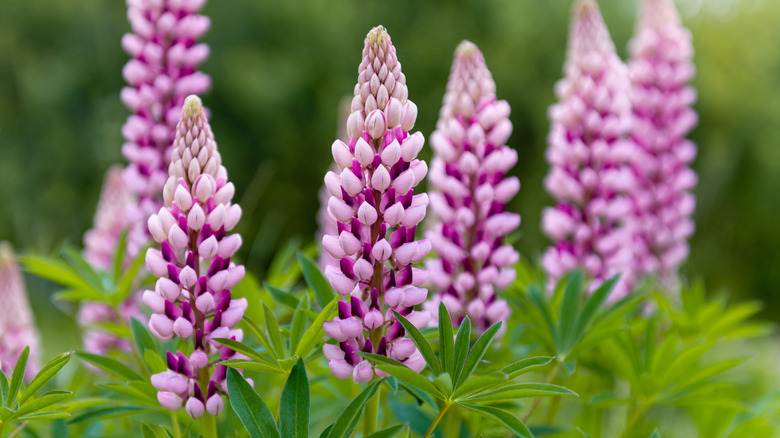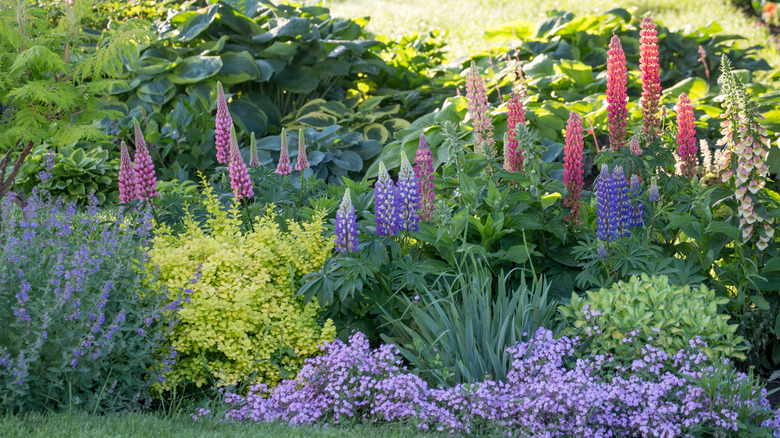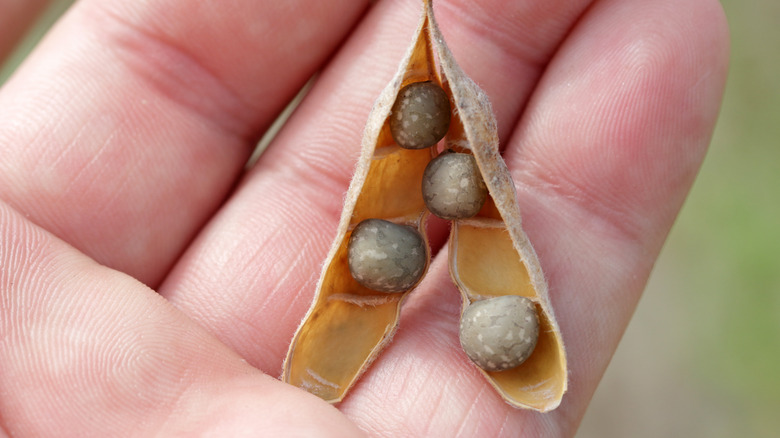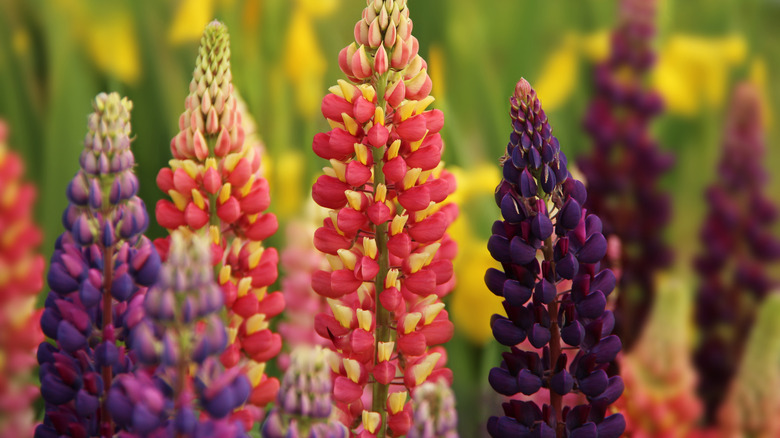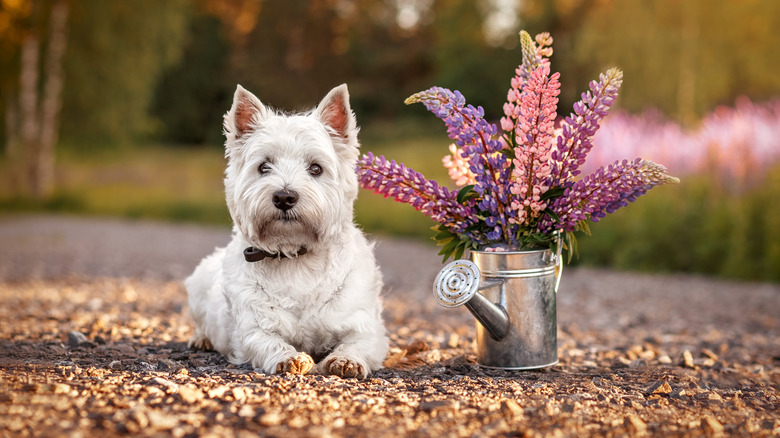Lupine Flowers: Everything You Should Know Before Planting
With tall spikes of densely-packed flowers, lupine flowers (scientific name lupinus) are a classic, beloved perennial known for adding interest, texture, and a wildflower feel to any garden. They can reach heights of nearly four feet, and come in shades of blue, purple, pink, red, white, and yellow. The unique shape and clustering of their flowers resembles pea pods (they're actually a member of the pea family, according to Garden Design), and they're primarily native to North America. In fact, perhaps the most famous lupine is the Texas Bluebonnet — so it's no surprise that it's also the state flower of the Lone Star State.
Lupines are easy to grow, non-fussy plants that self seed like a dream. They perform well in challenging environments, though it's important to note that they don't respond well to transplanting. Their ability to grow in less-than-hospitable places actually caused early Europeans to believe that lupines were stealing nutrients from everything around them, so they named them "lupine" after their word for wolf (lupinus) because wolves were also notorious for stealing, explains Florgeous. It turns out lupines actually enhance the soil. Read on to find out how they do this and everything else you need to know before planting.
How to use lupine flowers in the garden
Because they can grow so tall, many gardeners choose to place lupines in the back of their flower beds. This is a great way to create depth and contrast because the tall, flowering stalks give vertical interest. Garden Design suggests planting them en masse in order to pack the greatest visual punch. If you choose to go this route, just make sure you don't cram them in too close together. The Old Farmer's Almanac recommends spacing them roughly a foot apart.
Lupines are a staple in both cottage-style and wildflower gardens. They pair beautifully with other cottage classics like phlox and allium. If you have a cutting garden, lupines are a great addition to it. Their unique appearance also adds a lovely touch of whimsy to any bouquet.
Additionally, you can plant lupine flowers in your vegetable garden if you want to improve the health of your soil, says Gardening Know How. An added bonus? They're deer-resistant, so they might serve as a deterrent if Bambi wanders into your garden.
How to grow lupine flowers
As we mentioned above, one of the great things about lupines is that they're not fussy or high-maintenance. The most important thing they do need, though, is sunshine. Plant in an area with full sun to guarantee the most vibrant, healthy blooms. Planting in partial shade can also work, but the blooms won't be as prolific, says American Meadows.
Lupines can be grown from seeds or as a mature plant from a container. If you go the seeds route, Gardening Know How suggests planting them in the fall so they can be naturally chilled in the ground throughout the winter. Otherwise, you'll need to soak the seeds overnight or place them in the refrigerator for several days to prepare them for planting.
When it comes to the soil, average is perfectly adequate. This isn't a plant that requires tons of fertilizer or compost because lupines actually improve the health of the soil by fixing the levels of nitrogen. You just want to make sure that the soil drains well so the deep root system doesn't get waterlogged.
How to care for lupine flowers
After you've picked a perfectly sunny spot for your lupine flowers, the next thing to consider is the pH level of your soil. Lupines thrive in acidic soil, so you may need to amend yours if it's too alkaline and the plant isn't performing well.
Once you've planted them, you'll want to keep the soil moist but don't go crazy with overwatering. After lupines have a chance to establish their root systems, they can fare pretty well during dry spells. However, if you live in an area that experiences scorching heat, you'll definitely want to add a layer of mulch and also be more diligent with watering, according to Garden Design.
If you go with an extra tall variety, you'll want to add stakes to give it proper support. Once it's in full bloom, the weight of the flowers will cause it to topple over unless there is adequate support. Additionally, most lupines benefit from deadheading in order to encourage a second round of blooms later in the season.
Varieties of lupine flowers
According to The Old Farmer's Almanac, there are over 200 varieties of lupine flowers, and nearly all are native to North America. People who live in the western half of North America are likely used to seeing meadows carpeted with wild lupines, or dottedalong the roadsides. We've rounded up some of the most beautiful varieties for your garden:
- Tutti Frutti (lupinus polyphyllus): Vibrancy abounds with this lupine's combinations of rich purples, magentas, and golden yellows. It grows in USDA zones 4 through 8, and will reach a maximum height of four feet.
- Pixie Delight (lupinus hartwegii nanus): On the smaller and less dramatic side, this lupine comes in soft pastel shades of pink, blue, and white. It can be grown in all zones and only reaches a maximum height of a foot.
- Alamo Fire (lupinus texensis): This wildflower variety grows as an annual and features a distinctive color pattern of red petals with white tips. It can be grown in all zones and will reach a maximum height of two feet.
- Golden Lupine (lupinus densiflorus var. Aureus): If you want to attract bees to your garden, choose this dazzling yellow lupine variety. It can be grown as an annual in all zones and reaches a maximum height of three feet.
- The Chatelaine (lupinus polyphyllus): This variety is known for its sweet aroma and combination of pink and white petals. It grows in USDA zones 4 through 8 and reaches a maximum height of four feet.
Are lupine flowers toxic?
If you have pets, you'll need to keep them away from any lupine flowers in the garden or bouquets inside the home. According to the Lady Bird Johnson Wildflower Center, lupine is toxic to animals — including livestock — if consumed in large doses. The seeds are the most toxic part of the plant because of their high alkaloid levels, with some varieties being more dangerous than others. The leaves also contain the toxin, but not at the same level as the seeds. Signs of poisoning include respiratory problems, slowed heartbeat, and convulsions.
Lupine seeds are only safe for human consumption after a treatment process that includes boiling and soaking, says the Patient Gardener. However, it's best to err on the side of caution and avoid them completely. Extra care should be taken with young children who could mistake the lupine's pea pod shape for normal peas and be tempted to eat them. Eating small doses will likely cause intestinal discomfort, and the true danger lies in larger doses, but it should be avoided altogether to prevent a potential medical emergency.
